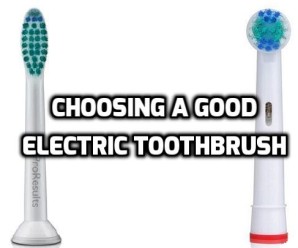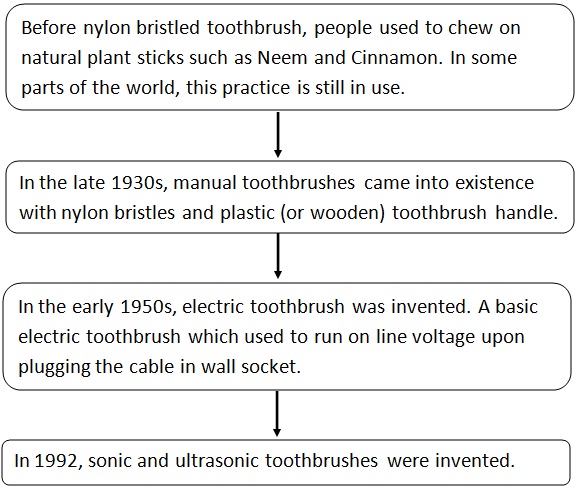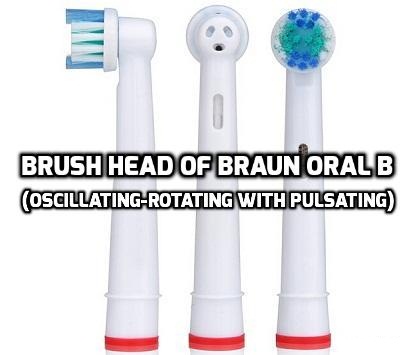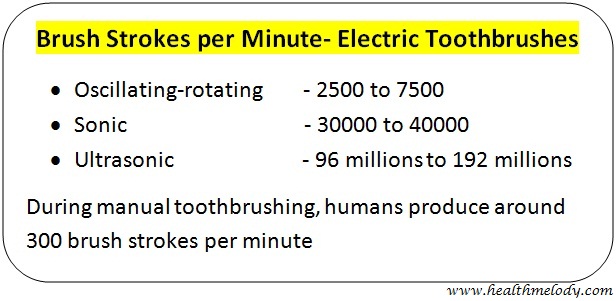
A good electric toothbrush: Rotating vs Sonic
Choosing a good electric toothbrush is quite a tricky job because so many companies are offering numerous models and every model boats to be the best when it comes to teeth cleaning.
The journey of toothbrush evolution is quite interesting:
In the course of time, various advanced models of manual toothbrushes have been launched with changes in:
- Bristles design- Flat, zig zag, criss cross, tapered
- Brush head- Rectangular or tapered
Flexible neck and non slippery grip are other value added features.
Read more: Criss cross bristles do better cleaning?
Similarly, powered (electric) toothbrushes have evolved with the addition of various value added features and cleaning mechanisms.
Electric toothbrushes- Value added features
- Rechargeable battery– The basic electric toothbrush models either use separate AA batteries for power or they just use a cable to plug into the wall socket. But, nowadays, most of the electric toothbrushes come with built-in rechargeable bases.
- Built-in brushing timers– According to the American Dental Association, the optimum brushing time is 2 minutes. With manual toothbrushes, it is hard to comply to this time standard. To solve this problem, a lot of electric toothbrushes come with inbuilt 2 minutes alarm. Some advanced models buzz alarm after every 30 seconds to make sure that you give equal time to each of the four quadrants of your mouth.
- Multiple cleaning programs– The earlier models had one basic cleaning program. But, the new models have multiple cleaning modes such as- daily clean, sensitive teeth, whitening, gum care, pro-clean and tongue clean.
- Pressure sensors– Excessive pressure can damage the gum line. Pressure sensors in electric toothbrushes would alert you from getting too hard with your teeth and gum line.
- Super soft grip– Super soft grip for better grip and control. Also, it reduces the feeling of vibrations while holding the brush.
- UV sanitizers– The most recent electric toothbrushes come with UV sanitizers to kill the left over bacteria on your toothbrush after use.
Electric Toothbrushes- Cleaning Mechanism
An electric toothbrush makes brushing easy. You just need to grip and place it properly on the gum line – it would take care of the rest.
So, how an electric toothbrush works actually? How it cleanses the teeth?
There are 2 basic cleaning mechanisms:
- Rotating
The cleaning mechanism in earlier, basic models of electric toothbrush was rotating- a small circular head which rotates to provide the cleaning action.
Then the concept of “rotating-oscillating” brush head came into light. It means- the brush head rotates in one direction and then the other.
These types of toothbrushes (rotating-oscillating) are found to be more effective in reducing dental plaque and gingivitis than manual toothbrushes as reported in the journal- Cochrane Database System Review, Apr 2005.
The recent development is- rotating – oscillating with pulsating action. It implies- along with the rotating-oscillating action, the brush head pulsates forward and backward. The latest Braun Oral B toothbrushes use this technology. These toothbrush heads produce as high as 40000 pulses per minute. It agitates the oral fluid (water, saliva and toothpaste) to produce a non contact cleaning effect to dislodge the plaque from areas where the bristles can’t reach.
In general, rotating brush heads with small, circular heads are designed to work on one tooth at a time.
Hence, they can clean those hard-to-reach areas better than vibrating type brush heads. Also, they offer better cleaning of back teeth due to better access.
- Vibrating (sonic and ultrasonic)
Electric toothbrushes with vibrating heads vibrate at a very high frequency to break down the dental plaque. The brush head moves side-to-side vibrating at a super high speed to scrub the bristles against the teeth. Such a high speed vibration generates a powerful pulsating action to agitate the oral fluid and produce the non contact cleaning effect (as in case of rotating-oscillating-pulsating toothbrushes). The brush head in vibrating toothbrushes resembles to manual toothbrushes- not circular as in case of rotating.
Generally, vibrating toothbrushes are costly than rotating ones.
Due to super-high vibration frequency, the brush strokes per minute is incredibly high in sonic and ultrasonic toothbrushes. This is certainly the most significant and highlighted feature of these modern age electric toothbrushes.
Which is better- Electric (rotating) or Sonic?
From a user’s point of view, it is quite a difficult decision because opinions differ widely among dentists and individuals. Hence, I tried to compile a few case studies published in various medical journals to draw a conclusion.
I found four case studies in the archives of The Journal of Clinical Dentistry.
- A case study published in the edition volume 2, 2013 compared the plaque and gingivitis reducing efficacy of oscillating-rotating and sonic toothbrushes. After a 12 week clinical comparison involving 130 adult volunteers, it was concluded that the oscillating-rotating toothbrushes performed better.
- Another case study published in the edition volume 8, 1997 involved 66 adults with periodontitis. Periodontitis refers to serious gum infection- inflammation around the teeth. The six months clinical comparison of oscillating-rotating (Braun Oral B) and sonic (Sonicare) toothbrushes concluded that both the toothbrushes reduced periodontitis symptoms considerably. When it comes to superiority, sonic model performed better.
- One more case study in the edition volume 6, 1995 conducted a clinical comparative study between oscillating-rotating and sonic toothbrushes in terms of plaque removing ability, safety and user satisfaction. After daily use for 8 weeks, both performed equally well in reducing dental plaque and gingivitis. There were no safety issues in both the devices as well. As far as user satisfaction is concerned, Braun Oral B (oscillating-rotating) was rated better than Sonicare (sonic).
- Another case study in the edition volume 4, 1996 conducted a plaque removing comparison between oscillating-rotating and sonic toothbrushes and found oscillating-rotating superior than sonic. During the study, 35 university students brushed their teeth under professional supervision.
And, a few more comparative studies in other journals as below:
- A 10-week comparative clinical study, as reported in the American Journal of Dentistry, Dec 2009, found oscillating-rotating toothbrush relatively better than sonic in plaque removal efficacy. However, both toothbrushes showed significant reduction in dental plaque.
- A clinical case study mentioned in the Journal of International Clinical Dental Research Organization, volume 2, 2010 labelled both the toothbrushes effective in removing dental plaque and gingivitis without any significant relative difference.
In my quest for picking the best electric toothbrush, I visited Quora as well. In an interesting discussion thread there, out of 9 replies, 6 favored sonic toothbrush.
The Bottom Line- A good electric toothbrush
Both the type of toothbrushes are quite effective in rubbing off the dental plaque. Among the case studies, certainly, oscillating-rotating toothbrush has an upper hand edge, but, user experiences bet for sonic toothbrush.
So, I would conclude that it is more of a personal choice. Both are good and capable- choose whatever suits you well.
Let us quickly re-cap what we have learnt:
- Oscillating-rotating (with pulsating action) and sonic- both types of electric toothbrushes can effectively remove the dental plaque and debris if used properly.
- Oscillating-rotating brushes have small, circular brush head while the brush head of sonic toothbrush is similar to that of a manual toothbrush.
- Due to super-high brushing strokes per minute, sonic and ultrasonic toothbrushes provides flossing action as well to clean the inter-dental areas.
- Sonic toothbrushes are less noisy.
- Generally, sonic toothbrushes cost more than rotating.
From where to Buy
Grab a new electric toothbrush from a departmental store near to you. You may check these below options at Amazon for some discounts. I’ve selected them after checking the brand value, user reviews and price.
Braun Oral B
If you are from USA, check here
If you are from UK, check here
If you are from India, check here
Philips Sonicare
If you are from USA, check here
If you are from UK, check here
If you are from India, check here
References
https://en.wikipedia.org/wiki/Ultrasonic_toothbrush
https://en.wikipedia.org/wiki/Electric_toothbrush
https://www.ncbi.nlm.nih.gov/pubmed/15846633
https://www.ncbi.nlm.nih.gov/pubmed/24282870
https://www.ncbi.nlm.nih.gov/pubmed/9487838
https://www.ncbi.nlm.nih.gov/pubmed/8694983
https://www.ncbi.nlm.nih.gov/pubmed/8739175
https://www.researchgate.net/publication/41547289_Comparison_of_rotationoscillation_and_sonic_power_toothbrushes_on_plaque_and_gingivitis_for_10_weeks
http://www.jicdro.org/article.asp?issn=2231-0754;year=2010;volume=2;issue=3;spage=136;epage=142;aulast=Dadlani






